Sure, tasty crabs and beautiful coastlines define Maryland and the Mid-Atlantic area, but our geography and weather is also unique to us.
Unfortunately, it’s not always a good thing.
This becomes especially clear when you look at the common types of chimney deterioration we see here in Maryland and the Mid-Atlantic.
Our water’s one of our best features, but when it comes to chimneys, it’s enemy #1.
What makes it so bad? Let’s take a look…
#1 Freeze/Thaw Damage & Mold.
The block or brick of our masonry chimneys absorbs so much water when we have snow, rain, or freezing rain.
That’s only natural because block and brick are porous.
But here in Maryland and the Mid-Atlantic, we also have erratic temperature changes, which means trouble.
It can be 55 degrees and raining in the middle of a January day, drop below freezing at night, and then the next day be 45 degrees and sunny.
Here’s what that looks like, and where the moisture becomes a problem:
- When it drops below freezing at night, all that water vapor that the masonry structure has sucked in freezes. When water freezes, it expands, which fractures the brickwork.
- When the temperatures rise again the next day and the sun comes out, the water thaws out. As a result, it takes up less space in the brick, which creates movement once again in the brickwork. That constant movement creatures micro-fissures in the brick, which makes the brickwork even more absorbent in the future.
The truth is, water can erode bricks, mortar joints, and even the cement slab on top of your chimney, which is called the chimney crown.
And once you start to get water penetration in the chimney, you can expect it to move into other areas of your home. You’ll have water leaking into wall spaces, going into the attic, into the roof trusses, etc. And in many cases, this ultimately means a mold issue, which is bad news not just for your health, but for your wallet.
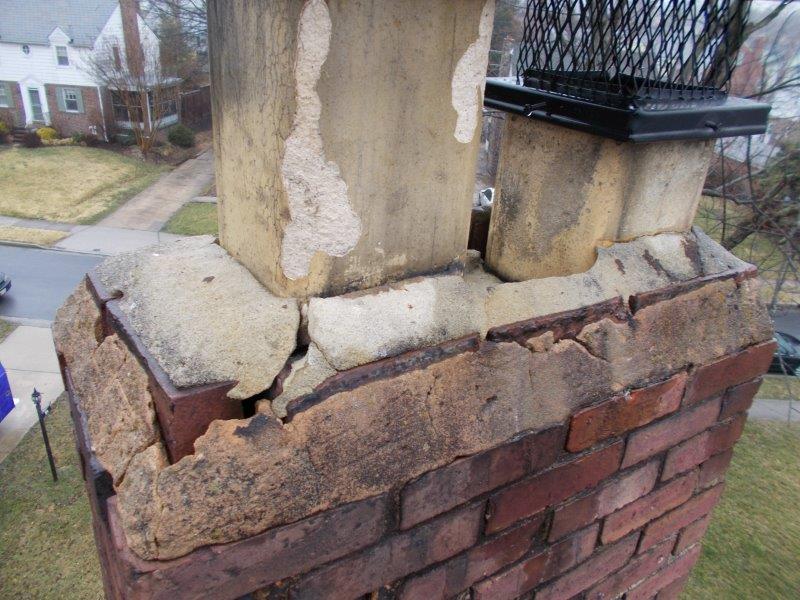
Chimney crown has completely deteriorated and is allowing water to seep through.
According to houselogic.com, you can expect to spend between $2,000 and $6,000 to remove mold from walls and attics, and between $10,000 and $30,000+ for more widespread structural damage due to mold.
Yikes! We can think of some better ways to spend that money, can’t you?
Even if you avoid a mold problem, water in the chimney can create other issues if not quickly stopped…
#2 Flue Liner & Smoke Chamber Damage.
If you get enough water in the chimney, then it starts to negatively affect the terra cotta flue liner.
These terra cotta tiles are set in mortar joints, and the mortar joints can start to wash away if water makes its way into the chimney system.
When these mortar joints wash away, you’re left with gaps in the flue liner, which creates inefficiency and safety problems. If water continues to make its way in, that water will also come through the shoulders of the chimney and wash the parging off of the smoke chamber.
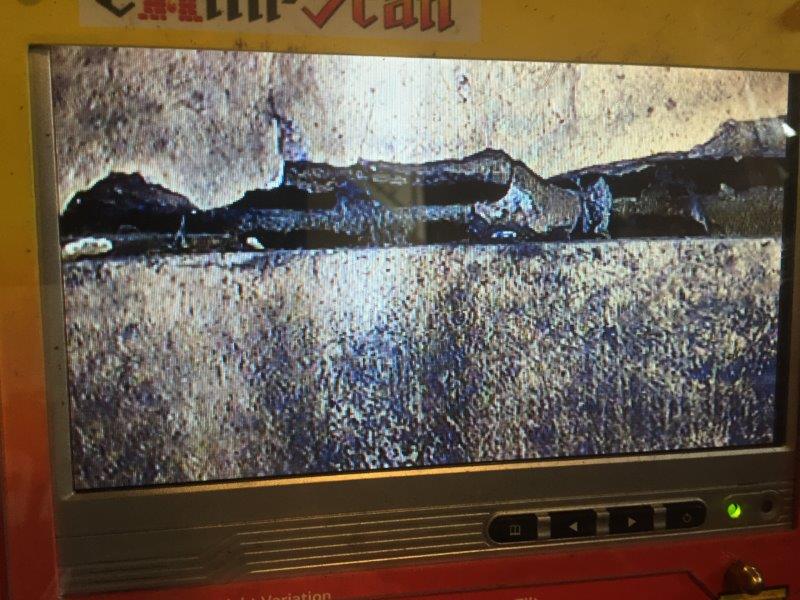
Missing mortar joints in the flue liner found using our Chim-Scan video inspection camera.
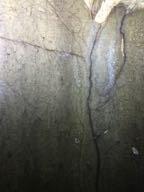
Cracks found in a chimney flue liner.
That’s kind of like the second step of this.
This can be a real danger because the smoke chamber is the area just above the fireplace, and things can get pretty heated in this area.
The smoke chamber must be parged smooth to prevent that heat from escaping and transferring to other areas of the home, and to move the smoke and byproducts of combustion up into the chimney flue so they can exit the home. When that parging is washed off by water, it weakens the safety and efficiency of the entire system.
#3 Vegetation Growth & Loosened Brickwork.
Another common type of chimney deterioration we see here that’s related to water is vegetation growth.
Take a look at the exterior of your chimney.
You may see either black mold growing on the exterior of the structure, green growth, or even small saplings growing out of brickwork. What this tells you is that the chimney is water-logged.
If the chimney didn’t have water in it, it wouldn’t be growing anything. But because there’s water in there, it starts to grow vegetation, which weakens the joints and loosens the brickwork.
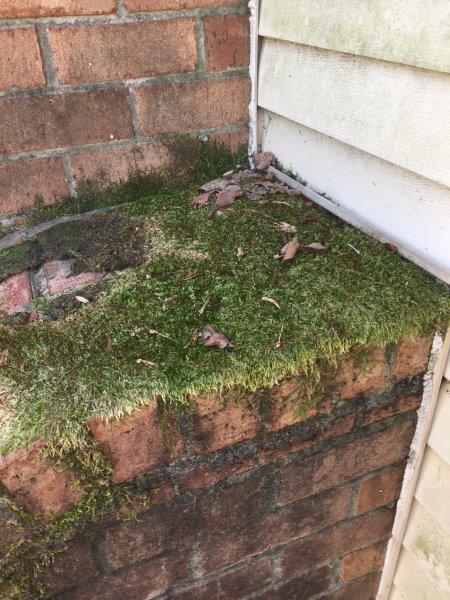
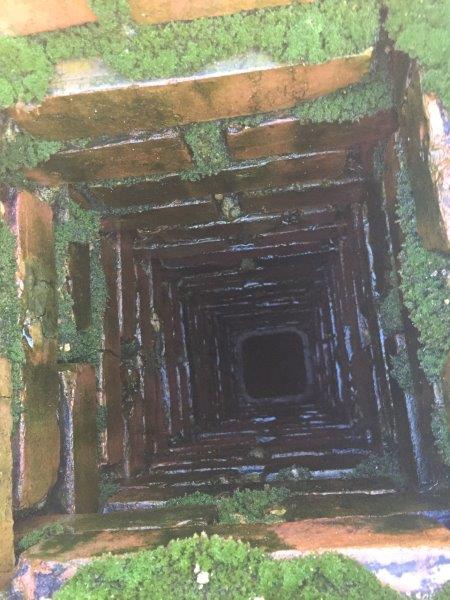
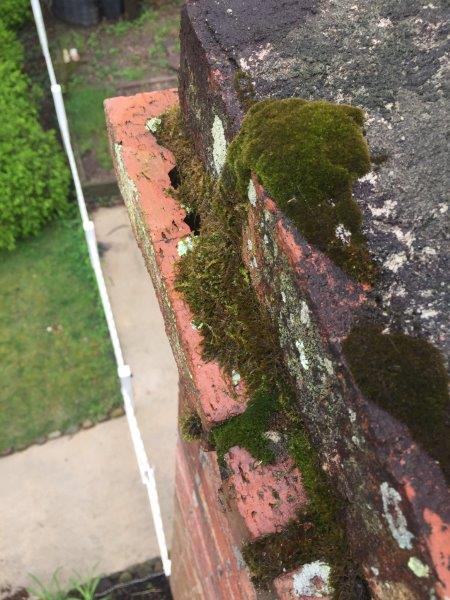
What About Non-Masonry Chimneys? Are They Prone To Water Damage, Too?
Truth is, a lot of the things we’ve covered can happen with chimneys that are covered in siding, as well.
The ones that are covered in siding are basically plywood, and instead of coming in through the masonry, water comes in through the siding or through the chase cover, which is the metal cover at the top of the chimney chase or box.
Most chase covers that are installed originally are made of galvanized metal, so they only have about a 10-15 year life expectancy before they start to rust.
When they rust and form holes, you have water coming inside the chimney chase or box, and the plywood swells and delaminates.
The water also leaches into the wall. So now you have a rusted chase cover, which is fairly expensive to replace, and the problem of wood rot and interior wall water damage, which isn’t cheap either.
What Can You Do To Prevent Chimney Deterioration, If Anything?
If you’re freaking out a little bit about your chimney and the threat of water damage, take a deep breath — it’s not all bad news!
Most of this type of chimney deterioration can be prevented at a very low cost through regular yearly inspections.
Think about it, whether it’s cutting your grass, painting your house every 5 years, re-blacktopping your driveway every other year, etc., there are some things that you just know you need to take care of as a homeowner.
It’s the same with chimneys.
Your chimney needs to be looked at regularly, even if you don’t use it.
The sooner you pick up on issues and address them, the more affordable and easier it will be to fix the problem. It’s like your car. If your car starts to make a noise and you drive it right to a mechanic, chances are the repair is going to be pretty inexpensive. If you drive it for another week, chances are you’ve done more damage, and now it’s a different story.
There are so many things you may not even think about, like wind load, storm damage, snow, rain, freezing rain, all of these things that can affect your chimney.
If you spend a small amount of money and have it inspected on a yearly basis and invest in preventative maintenance, you can save yourself thousands and thousands of dollars.
So don’t underestimate the return on investment of a yearly inspection. Aside from keeping up with annual inspections, what else can you do?
Here are our 4 top tips for preventing chimney damage and deterioration:
- Keep your chimney properly maintained. We’ve already touched on this a little bit, but keep up with cleanings and maintenance. When repairs are needed, try to get them done ASAP. This could save you a bundle in the long-run.
- Waterproof the chimney, don’t paint it. There are water-repellent products that are designed specifically for chimneys, and these can greatly reduce your water deterioration risk and prolong the life of your chimney. We use a product which is breathable, like a Gore-Tex raincoat. This lets the water inside the chimney wick away, but it won’t allow the water from outside the chimney to come in. The worst thing you can do to your masonry chimney is to paint it, because chimneys have to breathe. When you heat and cool the flue liner — whether that’s due to use of the system or temperature changes that happen as the weather changes in a 24 hour period — you create condensation inside the masonry structure, and that needs to escape. If it can’t escape, it stays inside and rots out the interior of the chimney. So when you apply a water repellent to your chimney, make sure it’s breathable.
- Make sure you have the correct type of chimney cap. Not all chimney caps are created equal. To prevent water damage, you need one that covers the entire top of the chimney and sheds the water off of the chimney and the crown. If you don’t see a chimney cap at the top of your chimney or you’re unsure if the one you have is adequately protecting the chimney, give us a call.
- Make sure you have a proper chase cover. A lot of times, chase covers that come standard aren’t all that great. For real protection against water deterioration, make sure you have a chase cover that has crossbreaks and drip edges, so that water is shed off of the top of the chimney and not down the sides of it.
What Else Do You Need To Know About Preventing Chimney Deterioration?
The biggest thing to remember with all systems is that you have to maintain them regardless of the fuel source.
You may have a direct vent gas fireplace — which has very little exposure to the outside and will vent directly through the wall — but these types of systems still need to be serviced, as far as the gas log units go, to make sure everything’s burning correctly.
If the system is not burning correctly, not only are you inefficient and wasting money and energy, but your glass will smoke up, and you’ll be putting different kinds of exhaust through your system.
If that exhaust has water vapor in it and it mixes with the acid residue, it will start to eat things out.
Why? Because the acid residue produced during combustion is sulfur-based (sulfuric acid), and when sulfur mixes with water, you’re left with some highly corrosive stuff.
This is commonly seen with an oil or gas furnace or boiler chimney flues which are very popular in Maryland.
That is why we stress to have your chimney for your boiler or furnace inspected yearly.
But here’s the thing: the same thing happens with wood.
When you burn wood, the flue gases are cooling as they rise through the flue liner, regardless of whether it’s a terra cotta flue liner or a factory-built unit with a metal flue liner.
As these gases cool, they stick to the flue liner and build up as creosote. Creosote and soot have a lot of nasty chemicals, which are corrosive, so even if you have a stainless steel liner in there, you don’t want that seeping through the joints. Plus, there are many parts of a factory built fireplace that aren’t stainless steel, and you can rust it out because of the creosote.
In a nutshell: regardless of the type of fireplace or chimney, maintenance is important.
Chimney Deterioration Prevention Is Easy With Clean Sweep Of Anne Arundel County
Has it been a while since you’ve had your chimney routinely inspected and checked for deterioration?
We’d be happy to come out and take a look.
Give us a call at 410-590-4800 or request an appointment online, and we’ll send a certified chimney professional to your home.
Remember, when it comes to chimney systems and annual inspections, one very small investment can have a very big return on your investment!
Psst! Another thing to keep in mind is that your factory-built fireplace is not meant to last forever.
You have to think of them sort of like a heat pump or a dishwasher. Factory-built fireplaces have a life expectancy of about 12-15 years and will need to be replaced at some point, just like any other appliance.
